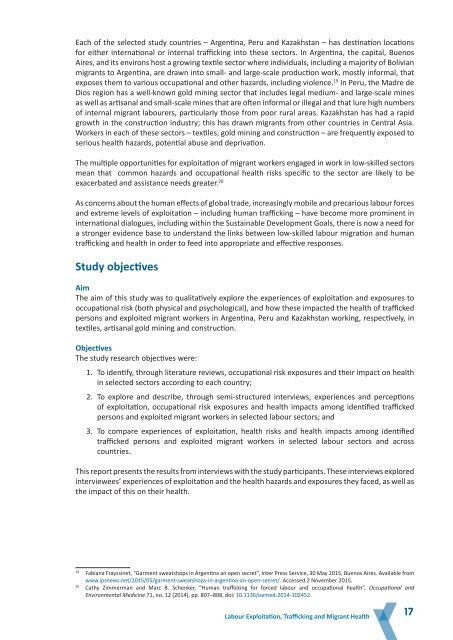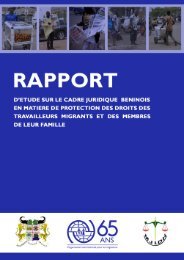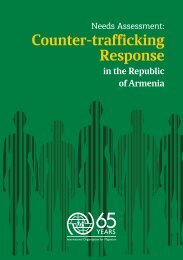Labour Exploitation Trafficking and Migrant Health
labour_exploitation_trafficking_en_0
labour_exploitation_trafficking_en_0
You also want an ePaper? Increase the reach of your titles
YUMPU automatically turns print PDFs into web optimized ePapers that Google loves.
Each of the selected study countries – Argentina, Peru <strong>and</strong> Kazakhstan – has destination locations<br />
for either international or internal trafficking into these sectors. In Argentina, the capital, Buenos<br />
Aires, <strong>and</strong> its environs host a growing textile sector where individuals, including a majority of Bolivian<br />
migrants to Argentina, are drawn into small- <strong>and</strong> large-scale production work, mostly informal, that<br />
exposes them to various occupational <strong>and</strong> other hazards, including violence. 19 In Peru, the Madre de<br />
Dios region has a well-known gold mining sector that includes legal medium- <strong>and</strong> large-scale mines<br />
as well as artisanal <strong>and</strong> small-scale mines that are often informal or illegal <strong>and</strong> that lure high numbers<br />
of internal migrant labourers, particularly those from poor rural areas. Kazakhstan has had a rapid<br />
growth in the construction industry; this has drawn migrants from other countries in Central Asia.<br />
Workers in each of these sectors – textiles, gold mining <strong>and</strong> construction – are frequently exposed to<br />
serious health hazards, potential abuse <strong>and</strong> deprivation.<br />
The multiple opportunities for exploitation of migrant workers engaged in work in low-skilled sectors<br />
mean that common hazards <strong>and</strong> occupational health risks specific to the sector are likely to be<br />
exacerbated <strong>and</strong> assistance needs greater. 20<br />
As concerns about the human effects of global trade, increasingly mobile <strong>and</strong> precarious labour forces<br />
<strong>and</strong> extreme levels of exploitation – including human trafficking – have become more prominent in<br />
international dialogues, including within the Sustainable Development Goals, there is now a need for<br />
a stronger evidence base to underst<strong>and</strong> the links between low-skilled labour migration <strong>and</strong> human<br />
trafficking <strong>and</strong> health in order to feed into appropriate <strong>and</strong> effective responses.<br />
Study objectives<br />
Aim<br />
The aim of this study was to qualitatively explore the experiences of exploitation <strong>and</strong> exposures to<br />
occupational risk (both physical <strong>and</strong> psychological), <strong>and</strong> how these impacted the health of trafficked<br />
persons <strong>and</strong> exploited migrant workers in Argentina, Peru <strong>and</strong> Kazakhstan working, respectively, in<br />
textiles, artisanal gold mining <strong>and</strong> construction.<br />
Objectives<br />
The study research objectives were:<br />
1. To identify, through literature reviews, occupational risk exposures <strong>and</strong> their impact on health<br />
in selected sectors according to each country;<br />
2. To explore <strong>and</strong> describe, through semi-structured interviews, experiences <strong>and</strong> perceptions<br />
of exploitation, occupational risk exposures <strong>and</strong> health impacts among identified trafficked<br />
persons <strong>and</strong> exploited migrant workers in selected labour sectors; <strong>and</strong><br />
3. To compare experiences of exploitation, health risks <strong>and</strong> health impacts among identified<br />
trafficked persons <strong>and</strong> exploited migrant workers in selected labour sectors <strong>and</strong> across<br />
countries.<br />
This report presents the results from interviews with the study participants. These interviews explored<br />
interviewees’ experiences of exploitation <strong>and</strong> the health hazards <strong>and</strong> exposures they faced, as well as<br />
the impact of this on their health.<br />
19<br />
Fabiana Frayssinet, “Garment sweatshops in Argentina an open secret”, Inter Press Service, 30 May 2015, Buenos Aires. Available from<br />
www.ipsnews.net/2015/05/garment-sweatshops-in-argentina-an-open-secret/. Accessed 2 November 2015.<br />
20<br />
Cathy Zimmerman <strong>and</strong> Marc B. Schenker, “Human trafficking for forced labour <strong>and</strong> occupational health”, Occupational <strong>and</strong><br />
Environmental Medicine 71, no. 12 (2014), pp. 807–808, doi: 10.1136/oemed-2014-102452.<br />
<strong>Labour</strong> <strong>Exploitation</strong>, <strong>Trafficking</strong> <strong>and</strong> <strong>Migrant</strong> <strong>Health</strong><br />
17





